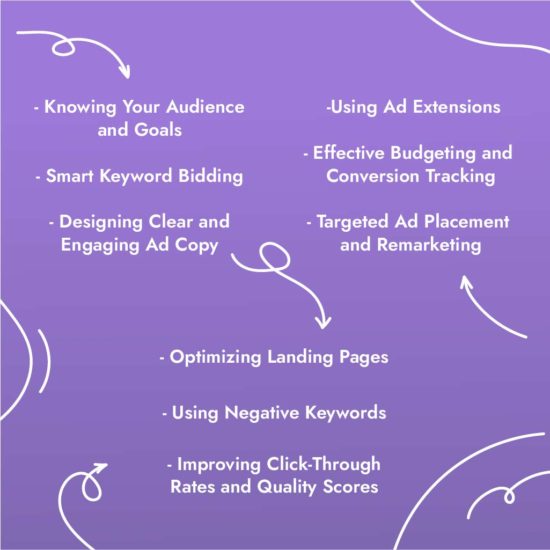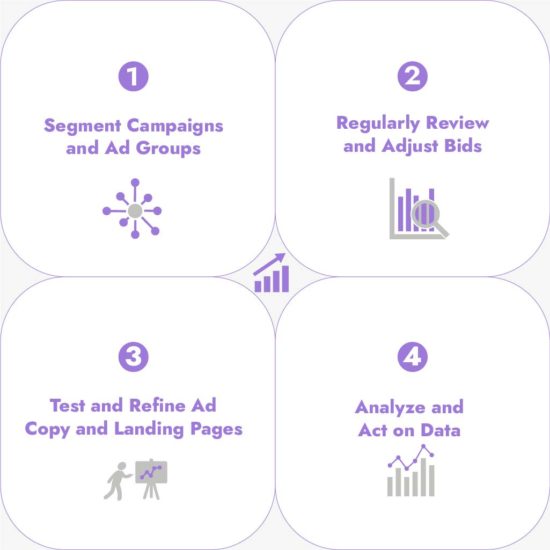Pay-per-click (PPC) advertising has become a crucial tool for businesses looking to grow online. They are one of the best digital marketing strategies for business growth. Why? Well, think of PPC as a shortcut to get your website noticed by potential customers quickly.
It’s a strategy for driving traffic, increasing brand awareness, and boosting conversions.
It’s like paying for a spot at the top of search results, making sure your business stands out. But, there’s a catch — you need to do it right to make the most of your investment.
Let’s go into the world of PPC and explore how to create campaigns that really work.
What is PPC Advertising?
PPC advertising is a type of digital marketing in which advertisers are charged a fee each time a click is made on one of their ads. It’s a method of buying website traffic rather than making an effort to “earn” it naturally.
Search engines are widely utilized for PPC campaigns, with Google Ads and Bing being two of the most popular platforms in this arena. For instance, it’s reported that approximately 80% of global businesses use Google Ads for their PPC efforts. This highlights the significant role these platforms play in the digital advertising landscape.
Does PPC Work Immediately?
Yes and no. While PPC can drive immediate traffic to your website, the full effect of its optimization efforts often unfolds over time. For instance, refining keywords, ad copy, and targeting can significantly improve campaign performance but may require ongoing adjustments.
Key Strategies of Effective PPC Campaigns

Here are the effective PPC strategies that you should consider:
1. Knowing Your Audience and Goals
Understanding your audience is like knowing whom you’re talking to at a party – it makes your conversation more relevant and engaging. Define your target audience’s age, location, interests, and online behavior. This allows you to make advertisements that appeal to them.
A local gym might target young professionals aged 20-35 interested in fitness. Their goal could be to increase sign-ups for their new yoga classes. They’d tailor their ads to highlight the health benefits of yoga, specifically for busy professionals.
2. Smart Keyword Bidding Strategy
Keywords are the bridge between your ads and your audience’s search queries. It’s crucial to choose keywords that are relevant to your products but also within your budget.
For a boutique pet store, instead of a broad term like “pet supplies,” more specific keywords like “organic dog food” or “handmade cat toys” could attract a more targeted audience without breaking the bank.
3. Crafting Clear and Engaging Ad Copy
Your ad copy should not only attract attention but also motivate action. It should clearly state what you offer and why it’s beneficial for the user.
For example, for an online bookstore, a compelling ad copy might be, “Dive into Your Next Adventure. Explore Our Wide Range of Mystery Novels. Free Shipping on Orders Over $50!”
4. Optimizing Landing Pages
The landing page must fulfill the promise made by your ad copy. A mismatch between the ad and the landing page can lead to higher bounce rates and lower conversions.
If an electronics retailer is advertising a sale on laptops, the landing page should directly showcase the laptops on sale, with reviews, specs, and an easy checkout process.
5. Improving Click-Through Rates and Quality Scores
A higher CTR indicates that your ads are relevant and appealing to your audience. Improving your quality score can reduce your cost-per-click and improve ad rankings.
A florist might improve CTR by using ad copy that highlights unique selling points, like “same-day delivery for handpicked fresh flowers.”
6. Using Ad Extensions
Ad extensions for PPC provide additional information and ways for users to interact with your ad, such as calling your business directly or accessing specific pages of your website.
A restaurant could use location extensions to show their address, call extensions for easy reservations, and site link extensions to direct users to their menu and booking page.
7. Effective Budgeting and Conversion Tracking
Setting a realistic budgeting for PPC campaigns is crucial based on your goals and market competition. Conversion tracking helps in understanding which ads are driving actions and are worth the investment. An online course provider could set a budget focused on the courses with the highest sign-up rates and use conversion tracking in PPC to monitor which ads lead to course enrollments.
8. Targeted Ad Placement and Remarketing
Targeted ad placement ensures your ads are shown to users who are most likely to be interested in your products or services. Remarketing in PPC focuses on visitors who have already engaged with your website.
An online fashion retailer might target users who visited their website but didn’t make a purchase, showing them ads for the products they viewed or added to their cart.
9. Using Negative Keywords in PPC
Negative keywords help avoid waste of ad spend on irrelevant queries, ensuring that your ads are shown to a more targeted and interested audience.
A luxury watch seller might use negative keywords like “cheap” or “discount” to ensure their ads don’t appear in searches that are unlikely to convert for their high-end products.
10. Geo-Targeting and Ad Position Optimization
Geo-targeting in PPC allows you to show your ads in specific geographical locations, while ad position optimization helps in getting your ads to a spot where they are more likely to be seen and clicked.
A local event planning service might use geo-targeting to reach customers within a specific city and adjust bids to appear in the top three search results for higher visibility.
By incorporating these detailed strategies and examples into your PPC campaigns, you can create more targeted, engaging, and effective ads that not only reach the right audience but also drive meaningful results for your business.
How Long Does it Take to See PPC Results?
The timeline for seeing results can vary. Initial traffic increases might be seen quickly, but optimizing for conversions and ROI might take weeks or months of refining strategies.
PPC’s effectiveness lies in its ability to target specific audiences with measurable results. For businesses seeking immediate visibility and a direct way to track ROI, PPC can be exceptionally effective. However, it requires continuous optimization and monitoring to maintain and improve its effectiveness over time.
Structuring Your PPC Campaigns for Results

Let’s check how to structure your PPC campaigns:
- Segment Campaigns and Ad Groups: Organize your campaigns by product or service category. Within each campaign, create specific ad groups based on more targeted themes or keywords.
- Regularly Review and Adjust Bids: Based on performance data, adjust your bids on keywords to ensure optimal spending and ROI.
- Test and Refine Ad Copy and Landing Pages: Regularly A/B tests different ad copies and landing pages to find the most effective combinations.
- Analyze and Act on Data: Use analytics to understand user behavior and campaign performance. Make decisions based on data to continuously improve your marketing.
Effective PPC Campaigns
Here are some examples of effective PPC campaigns, showcasing a variety of strategies and industries:
Local Service Provider (Plumbing Company)
- Campaign Goal: Increase emergency service calls.
- Strategy: Targeted local keywords like “emergency plumber in [City Name]” and “24-hour plumbing service.”
- Ad Copy: “[City Name] Offers Fast and Reliable 24/7 Emergency Plumbing Services. Call Now!”
- Result: High click-through rates and an increase in emergency service bookings, particularly during after-hours.
E-commerce Retailer (Fashion Boutique)
- Campaign Goal: Boost sales of a new summer collection.
- Strategy: Use of dynamic search ads targeting fashion-related queries and retargeting ads for visitors who viewed the collection but didn’t purchase.
- Ad Copy: “Step into Summer with Our Latest Collection. Exclusive 20% Off This Week Only!”
- Result: Increased sales of the summer collection, with a significant portion attributed to returning visitors.
B2B Software Company
- Campaign Goal: Generate leads for a new software product.
- Strategy: Targeted ads towards industry-specific keywords and LinkedIn PPC campaigns aimed at professionals in relevant industries.
- Ad Copy: “Revolutionize Your Workflow with [Software Name]. Request a Free Demo Today!”
- Result: A high number of demo requests and a subsequent increase in qualified leads.
Educational Platform (Online Courses)
- Campaign Goal: Increase enrollments in coding courses.
- Strategy: Targeted keywords related to coding and programming education, along with remarketing to users who visited course pages but didn’t enroll.
- Ad Copy: “Master Coding from Home: Enroll in Our Accredited Online Coding Courses – Limited Seats!”
- Result: Higher enrollment rates, especially in targeted coding courses.
Travel Agency
- Campaign Goal: Promote special deals on tropical vacation packages.
- Strategy: Seasonal ad campaigns targeting winter months in colder regions, using enticing images and ad extensions for quick booking.
- Ad Copy: “Escape the Cold: Tropical Getaways at Unmatched Prices. Book Now!”
- Result: Increased bookings for vacation packages during the targeted season.
Health and Wellness Brand (Supplement Store)
- Campaign Goal: Increase online sales of a new wellness supplement.
- Strategy: Keyword targeting around wellness and health supplements, coupled with a Google Shopping campaign showcasing the product.
- Ad Copy: “Boost Your Wellness with Our All-Natural Supplements. Special Launch Offer Inside!”
- Result: Notable rise in online sales for the new supplement, attributed to PPC campaign visibility.
Automotive Dealer
- Campaign Goal: Increase showroom visits and inquiries for a new car model.
- Strategy: Geo-targeted ads focused on local buyers, highlighting special financing deals and features of the new model.
- Ad Copy: “Schedule a Test Drive Now and Learn About Special Financing Options.”
- Result: Increased inquiries and showroom visits, leading to higher sales of the advertised model.
In summary, PPC advertising is a highly effective and versatile tool for digital marketing. Its success lies in understanding your target audience, selecting the right keywords, creating engaging ad copy, and continuously optimizing your campaigns.
PPC offers immediate visibility, targeted reach, and measurable results, adaptable to various marketing goals like increasing sales, generating leads, or improving brand awareness. With the right strategy and ongoing adjustments, PPC can deliver a significant return on investment, making it a crucial element of modern digital marketing strategies.




